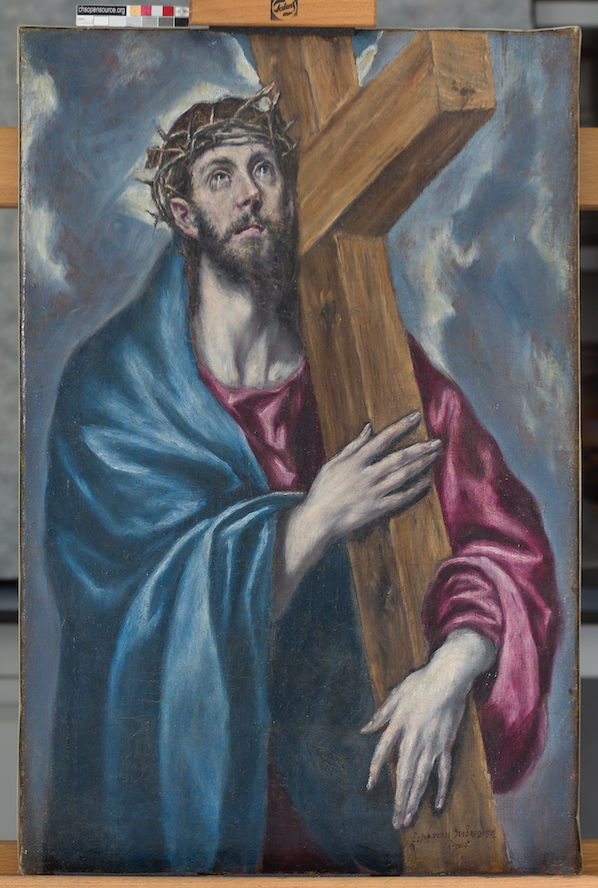Is This Religious Scene a Long-Overlooked El Greco Painting?
A team of Spanish scholars spent two years assessing the small-scale depiction of Christ carrying the cross
:focal(331x259:332x260)/https://tf-cmsv2-smithsonianmag-media.s3.amazonaws.com/filer/db/99/db99818e-f30e-4bf3-a57b-4d9f337c8a1d/detail_1.jpg)
Known for his elongated renderings of the human body and innovative use of color, El Greco is widely regarded as an exceptional 16th-century Renaissance artist. Now, reports Ferran Bono for Spanish newspaper El País, experts say they’ve authenticated a previously unknown painting by the Greek Old Master. (At least one art historian has disputed the attribution.)
Scholars from the Center d'Art d'Època Moderna (CAEM) at the University of Lleida in Catalonia assessed the artwork at an anonymous collector’s request. CAEM’s director, Ximo Company, collaborated with the late Carmen Garrido, founder of the Prado Museum’s Technical Documentation Cabinet, and historian Mariona Navarro to verify the religious scene’s authenticity through more than two years of research and technical analysis.
The roughly 23- by 15-inch artwork depicts Jesus wearing a crown of thorns and carrying a wooden cross. Awash in cool hues of lead white, blue, gray and yellow, he looks up at an ominous, charcoal-colored sky.
El Greco created multiple depictions of Christ carrying the cross throughout his career. One of the earliest versions, now housed at the Metropolitan Museum of Art, features a similar composition: “[It] is not a narrative scene,” the Manhattan museum notes on its website. “[N]o other figures are represented and the setting is not recognizable. Instead, it is a devotional image of haunting immediacy.”
In addition to drawing comparisons to the Met’s Christ Carrying the Cross (1577–87), the CAEM team observed marked similarities to paintings housed at the El Greco Museum in Toledo and the Prado in Madrid.
As Claire Selvin explains for ARTnews, the researchers suggest that the work went unnoticed because El Greco “kept it stored in his workshop and did not show it widely during his lifetime.” The artist may have used the small-scale painting as a model or guide for later works, Company tells El País.
“However, due to the refined finish of this exquisite work, in addition to its small size, it could also be a work conceived for a private oratory of a noble or clergyman,” he adds, per Google Translate.
Some experts are skeptical of the attribution.
Speaking with the Art Newspaper’s Gareth Harris, Fernando Marías, an art historian at Madrid’s Universidad Autonoma, says, “Although I have only seen the pictures in El País and on Twitter, the painting is doubtful [as an autograph work by El Greco]. It looks reworked and restored—the mouth is terrible, so are the cross, hands and signature.”
Marías also questions the canvas’ lack of provenance and the team’s paucity of technical details.
“Nothing has been said on the material aspects of the canvas or published radiographs or other types of material,” he says. “I won’t trust it until I see all the materials they could have gathered.”
El equipo del CAEM estudia Cristo con la cruz a cuestas, obra de Doménikos Theotokópoulos, El Greco, realizada hacia 1585-1590. pic.twitter.com/vrz2ob3yZ0
— CAEM | UdL (@caemudl) January 4, 2021
Company and his colleagues maintain that the painting was produced by the master himself rather than by members of his workshop or students. The team plans on publishing an 80-page report, complete with around 100 images, in support of its findings. If the researchers—who have previously validated works including a portrait by Diego Velázquez—can confirm the authentication, the painting’s value will increase significantly.
“Reviewing published documentation, it is known that in the inventory of El Greco's assets, made by his son Jorge Manuel Theotocópuli between April 17 and July 7, 1614, mention is made of a painting with the title Christ With the Cross on His Back; this could refer to our work,” Company tells El País.
Born on the island of Crete in 1541, El Greco started out as a Byzantine icon painter. In 1567, he moved to Venice, where he drastically changed his style after studying the works of Titian, Tintoretto and Michelangelo, according to Kyle MacMillan of the Chicago Sun-Times. The artist relocated to Rome in 1570 and to Spain, where he lived and worked until his death in 1614, seven years thereafter.
El Greco’s oeuvre went largely forgotten until the end of the 19th century, when artists like Pablo Picasso “rediscovered” his oeuvre, as Rebecca Long, a curator at the Art Institute of Chicago, told Marc Vitali of WTTW News last March.
“He was seen as very eccentric, mystical, too Catholic,” Long said. “… [I]t’s really the avant-garde writers and artists who rediscover him, the most famous would be Picasso, who knew of him from growing up in Spain.”
/https://tf-cmsv2-smithsonianmag-media.s3.amazonaws.com/accounts/headshot/Isis_Davis-Marks_thumbnail.png)
/https://tf-cmsv2-smithsonianmag-media.s3.amazonaws.com/filer/1c/f9/1cf9225f-a96d-4783-94e0-934ddc823a0f/dp347226.jpg)
/https://tf-cmsv2-smithsonianmag-media.s3.amazonaws.com/filer/55/29/552971fa-d1c9-4cff-b778-e26845569908/eq4ejvoxeaec44z.jpeg)

/https://tf-cmsv2-smithsonianmag-media.s3.amazonaws.com/accounts/headshot/Isis_Davis-Marks_thumbnail.png)